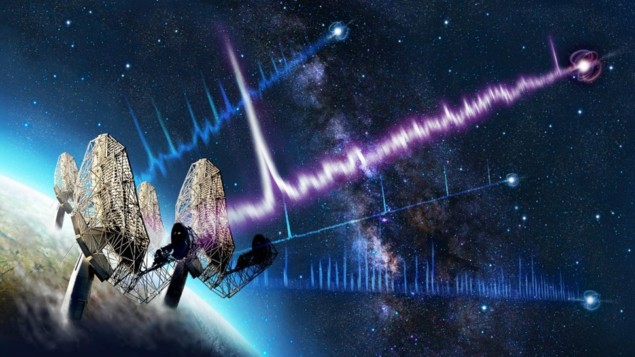Slowest ever neutron star is found in cosmic graveyard
14 Jun 2022
An unusual pulsating radio signal emerging from a “stellar graveyard” could be evidence for a new class of neutron star, according to an international team of scientists. The pulsar signal comes from a 53 million-year-old neutron star rotating once every 76 s – making this the slowest rotating neutron star ever observed. The star has been designated PSR J0901-4046 and was found by the MeerKAT radio telescope in South Africa.
A neutron star is an object with a mass similar to the Sun, but has been squashed by gravity to a diameter of about 20 km. Angular momentum is conserved as the star is compressed, which means that the rotational velocity of the star increases – much like how a twirling figure skater speeds up when she pulls her arms in.
Rotating neutron stars are well known to broadcast beams of radio waves that appear as pulses to observers on Earth. The radio-emission process is driven by the rotation of the star and this transfer of energy eventually slows the rotation to the point where emissions are expected to stop.
Unexpected pulsations
“What is surprising about this discovery is that it resides in the neutron star graveyard. That makes it special,” explains Manisha Caleb at the University of Sydney, who was lead researcher on the project. “We do not expect any radio pulsations in this region. This discovery has opened up a whole unexplored region where we hadn’t looked for neutron stars before.”
“This is the slowest known neutron star yet,” adds Caleb, who is the lead author of a paper in Nature Astronomy that describes the discovery. “The very fact that it does emit radio waves challenges our understating of how neutron stars age.”
The slowest neutron star previously spotted has a period of 23.5 s, meaning this new find is about three times slower. PSR J0901–4046 seems to have at least seven different pulse types some of which are strongly periodic. This diversity of pulse types is something the researchers say has never been seen before.
Quasiperiodic pulses
“No other known neutron star shows this variety. The ‘quasiperiodic’ pulse type could be due to seismic vibrations or oscillations of the neutron star — which could be important clues to the emission mechanism producing these bursts,” Caleb says. “This is the beginning of a new class of neutron stars. How or whether it relates to other classes is yet to be explored.”
Caleb, formerly of the University of Manchester, explains that the observation involved more than a little good fortune. “The fact that the source is only ‘on’ for around 0.5% of the rotation period means that we were very lucky for the beam to have intersected the Earth,” she said. “We may well be missing a whole population of these objects that we didn’t know even existed until now.”
“Pulsars are neutron stars with beams of radiation emerging from their magnetic poles that sweep across the earth as they rotate, allowing astronomers to detect them as a series of regular pulses,” Co-author of the Nature Astronomy paper and University of Oxford astrophysicist, Ian Heywood, told Physics World. “We can use radio telescopes to time the rotation of such neutron stars with extreme precision, making pulsars extremely fortuitous resources for testing numerous aspects of astrophysics and fundamental physics.”
Fortuitous and fundamental
Heywood adds that two of the fundamental things that researchers can observe about neutron stars are the rate of their rotation and the rate at which this rotation is slowing.
“Theories about neutron stars predict that for some combinations of these two values the radio emission will shut off and the beams will disappear,” he says. “The fact that we see radio emission from this object with such a long rotation period challenges some of these theories.”
Heywood points out that the values of PSR J0901–4046’s rate of rotation and slowing — technically referred to as its parameter space — mark it out as something new.READ MORE

“Different classes of pulsing neutron stars occupy quite distinct regions of parameter space, and this discovery is pushing towards regions that do not contain any known class of neutron star,” Heywood explains. “Perhaps it is not a new class of neutron star, but rather our understanding of the current known population is incomplete. Either way, this discovery questions our understanding of this type of object.”
The researchers say that by fully exploiting data from MeerKAT and by combining the observational techniques of the telescope’s MeerTRAP and ThunderKAT projects, they hope to search for more objects like PSR J0901–4046.
“Finding more of these neutron stars could prove vital to our understanding of the galactic neutron star population,” Caleb concludes.
Rob Lea is a science writer based in the UK.
from physicsworld.com 18/6/2022

Δεν υπάρχουν σχόλια:
Δημοσίευση σχολίου